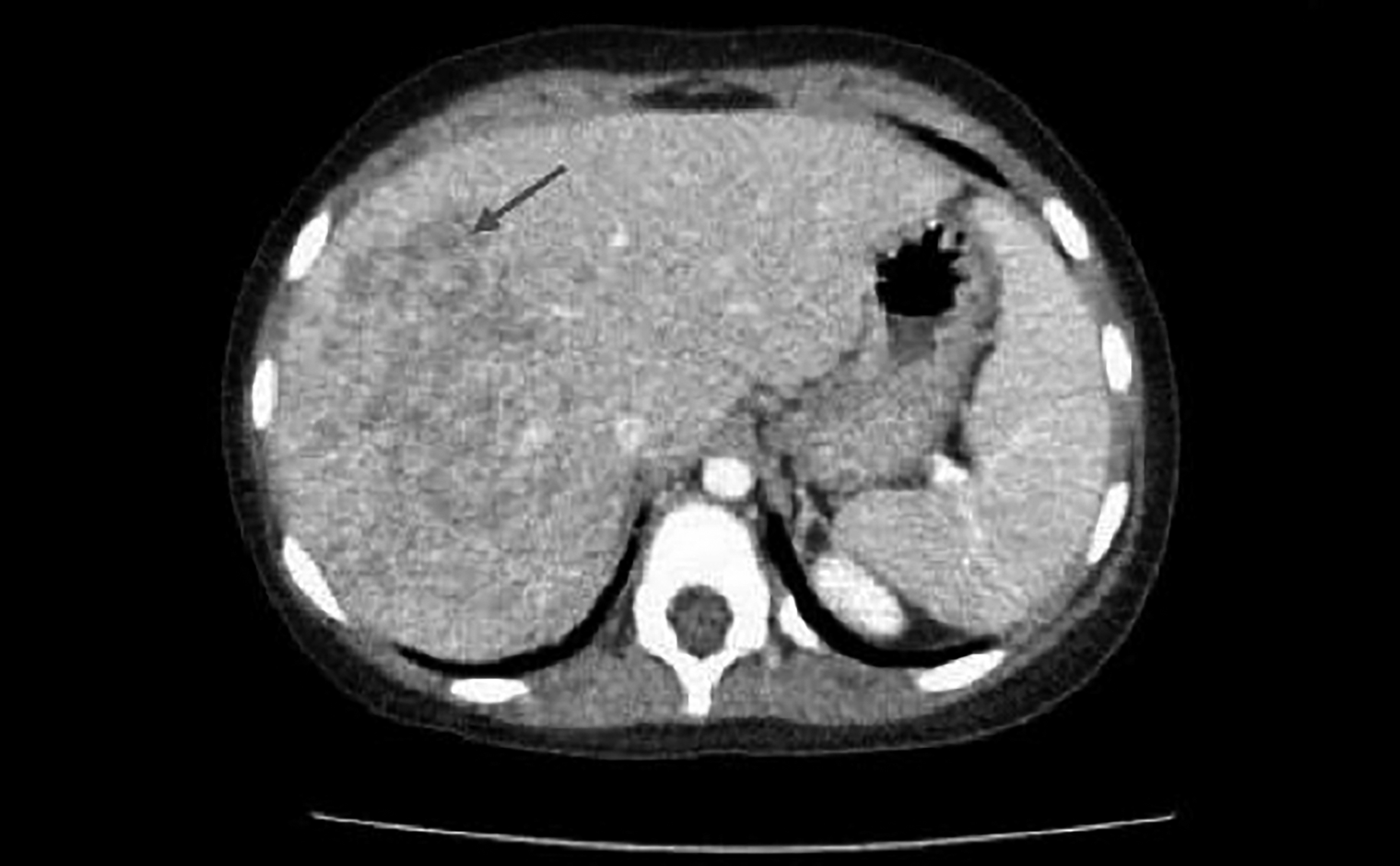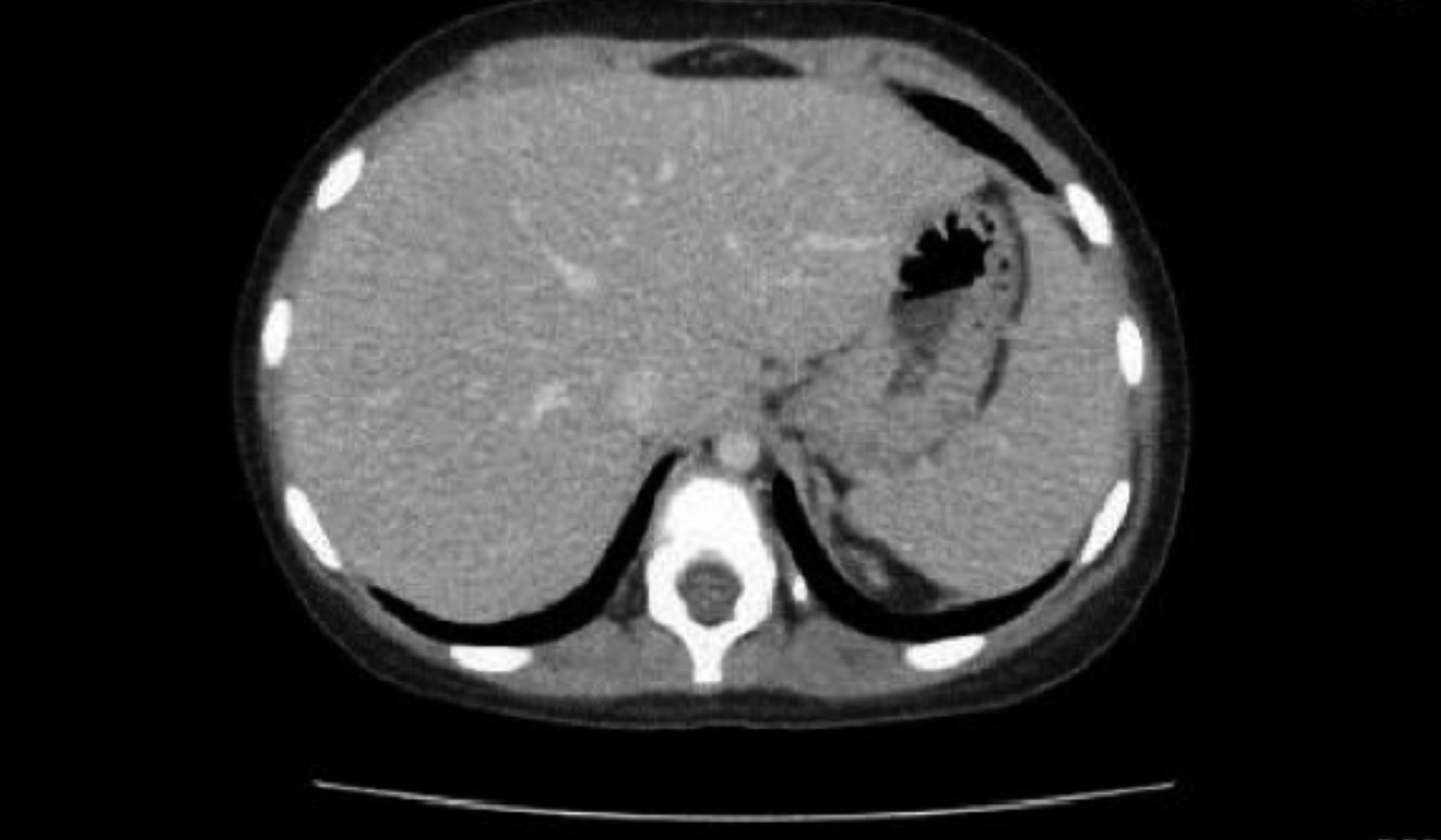

Affiliations
ABSTRACT
Brucellosis is a multisystem disease often caused by occupational exposure to animals or animal products. Hepatic involvement is not rare given the affinity of Brucella for the reticuloendothelial system but hepatic brucelloma, a necrotising inflammation of hepatocytes leading to formation of microabscesses, is a rare chronic condition. There is sparse data on clinical presentation and outcome of hepatic brucellosis. We, hereby, report a case of a young girl who presented with pyrexia of unknown origin and was found to have microabscesses in the liver and significantly raised Brucella serology titers. Her fever settled and hepatic lesions resolved with 6-week course of anti-Brucella treatment.
Key Words: Liver, Brucella, Zoonosis, Brucelloma.
INTRODUCTION
Brucellosis is the second most common zoonotic disease globally after rabies transmitted through wild and domestic livestock such as goats, sheep, and cattle. It remains a neglected disease in southeast Asia including Pakistan. Animals are the reservoirs of this illness and principal transmission is through contact with tissue, ingestion of unpasteurised milk and dairy products.1
Liver involvement in brucellosis results in a wide range of clinical manifestations from mild elevation of liver enzymes to abscess formation. If left untreated, it may result in decompensation and cirrhosis of liver.2,3
Herein, we report a case of a young girl with fever of unknown origin and multiple small microabscesses in the liver along with raised Brucella antibody titers from an endemic region.
CASE REPORT
An 8-year girl presented with a 25-day history of high-grade fever, fatigue, and abdominal pain. She had high-grade fever with chills and rigours (axillary temperature of 39–40°C), 3–4 times in a day. She denied any other associated symptoms. She went to multiple hospitals and was managed as enteric fever and received intravenous ceftriaxone and azithromycin, but the fever persisted.
The condition of the patient was getting worse. She denied nausea, vomiting, joint pain, backache, blurry vision, melena, or weight loss. She had no recent travel history or contact with a sick person. She lived with parents and three siblings. Her father worked in a private company and mother was a housewife. She had no significant past medical and surgical history. She was referred to infectious disease clinic for the evaluation of fever of unknown origin (FUO).
A thorough medical examination was undertaken. The physical examination revealed sick-looking, febrile, and tachycardiac child. The blood pressure (BP) was 85/50 mmHg and heart rate was 95 beats/minute. On abdominal examination, her liver was enlarged one finger below the right costal margin. The rest of the physical examination was unremarkable.
The laboratory work-up showed pancytopenia with haemogloblin (Hb) of 9 g/dL, white blood cells (WBCs), 3.5×109/L, and platelets count of 87000/mL. Aspartate aminotransferase (AST), alanine aminotransferase (ALT), and lactate dehydrogenase (LDH) were elevated. Malaria parasite on peripheral film was negative. Two sets of blood cultures showed no growth after a prolonged incubation for 21 days. Anti-amoeba antibody titers were negative. Chest radiograph was unremarkable. Further evaluation of risk factors showed no ingestion of unpasteurised milk but found out recent past significant history of exposure to animals due to Eid-ul-Adha festival. Echocardiography, CT of abdomen and Brucella serology were recorded. CT of abdomen showed hepatomegaly with microabscesses and multiple sub-centimetric para-aortic lymph nodes (Figure 1). Transthoracic echocardiography was unremarkable for any presence of vegetations. Brucella serology was positive with titers of 1:320 for B. militensis and 1:640 for B. abortus. A presumptive diagnosis of hepatic brucellosis was made on the basis of risk exposure, clinical and radiological evidence, and significant positive Brucella antibody titers. Definitive diagnosis required isolation of the bacterium from the blood or tissues and remained an elusive target in this case. She was started on Trimethoprim-Sulfamethoxazole and Rifampicin. Defervescence of fever occurred within one week, and she remained on outpatient follow-up. The lesions almost resolved on repeat CT scan imaging (Figure 2) at the end of the treatment and Brucella antibody titers also came down. Her clinical condition improved gradually after receiving 6 weeks of therapy and she was symptom-free after completion of the antibiotics therapy.
 Figure 1: CT Scan of abdomen (arrow showing micro abscess).
Figure 1: CT Scan of abdomen (arrow showing micro abscess).
 Figure 2: Repeat CT scan at the end of treatment showing complete resolution of micro abscess.
Figure 2: Repeat CT scan at the end of treatment showing complete resolution of micro abscess.
DISCUSSION
Brucellosis is a multisystem disease often caused by occupational exposure to animal and animal products. Pakistan is considered as one of the endemic countries for brucellosis.4 Studies have shown the overall seroprevalence of brucellosis in Pakistan to be around 17%.5
Hepatic involvement is not rare given the affinity of Brucella for the reticuloendothelial system. Hepatic brucelloma is a necrotising inflammation of hepatocytes that leads to formation of microabscesses and is a rare chronic condition that usually develops after years of infection. It is observed in 1.7% of individuals as a manifestation of systemic infection.6,7 In the present case, although the history was short, significantly high titers of Brucella antibodies and hepatic microabscesses formation pointed towards acute presentation of illness. Definitive diagnosis of brucelloma could be made by positive tissue or pus culture from an abscess but an anamnestic history of brucellosis, radiological findings and positive serology were suggestive of hepatic brucelloma.8
Laboratory diagnosis of brucellosis in children is based on positive blood or other sterile fluid culture and/or positive Brucella serology. Sensitivity of blood culture in first 2 weeks of illness is up to 90% and decreases to 30% as the disease progresses. Adequate amount of blood volume (3-5 ml for young and >5ml for older children) should be drawn and inoculated in paediatric culture bottles and incubated for up to 21 days in cases with high index of suspicion.9 Serological tests including serum agglutination test (SAT) or enzyme-linked immunosorbent assay (ELISA) remain the best diagnostic modality due to poor yield of blood cultures in chronic disease. A titer of >1: 160 in a clinically suspected patient is highly indicative of Brucella infection.6
Management of brucellosis in children depends on severity of illness and needs a combination of antibiotics that act intracellularly for prolonged duration to prevent relapses.9 The treatment duration of hepatic brucelloma is not optimised. It depends on resolution of symptoms, disappearance of lesions on repeated scans and usually takes 6 weeks to 3 months. Percutaneous drainage for culture or surgical resection may be required if lesions persist despite the medical therapy.6,10,11 In the absence of severe illnesses, like endocarditis or neurobrucellosis, in young children <8 years, a combination of Rifampicin and Trimethoprim-Sulfamethoxazole (TMP–SMX) is recommended. In contrast, in children older than 8 years, Doxycycline is used in combination with Rifampicin or Gentamicin in uncomplicated brucellosis cases.9 Brucellosis has usually good prognosis, if treated properly.11 Poor prognosis is observed in spondylitis and neurobrucellosis with severe neurodevelopmental sequelae.12
In conclusion, brucellosis has multisystem involvement like tuberculosis. Any patient presenting with hepatic or splenic abscesses in regions where brucellosis is endemic needs a thorough clinical and laboratory evaluation with blood cultures and serological testing to rule out brucellosis as a possible aetiology.
PATIENT’S CONSENT:
Informed consent was obtained from the patient.
COMPETING INTEREST:
The authors declared no conflict of interest.
AUTHORS’ CONTRIBUTION:
SJ: Conceptualisation and design of work.
ZUD: Manuscript-writing.
All authors approved the final version of the manuscript to be published.
REFERENCES